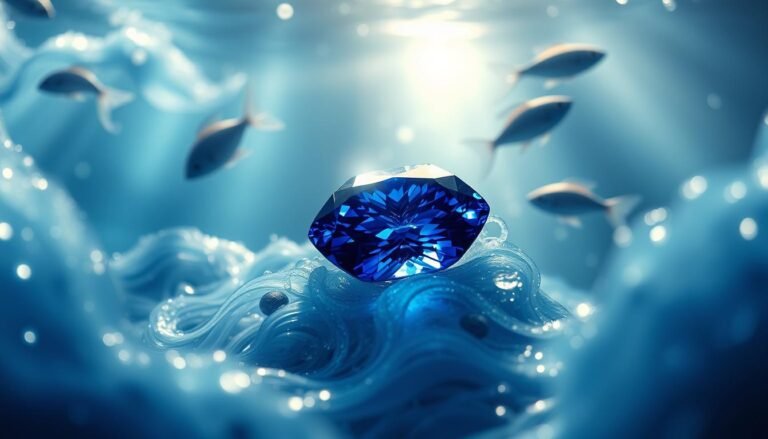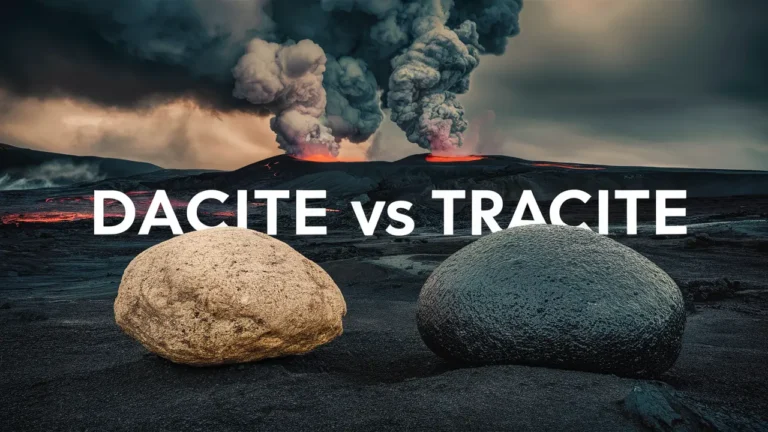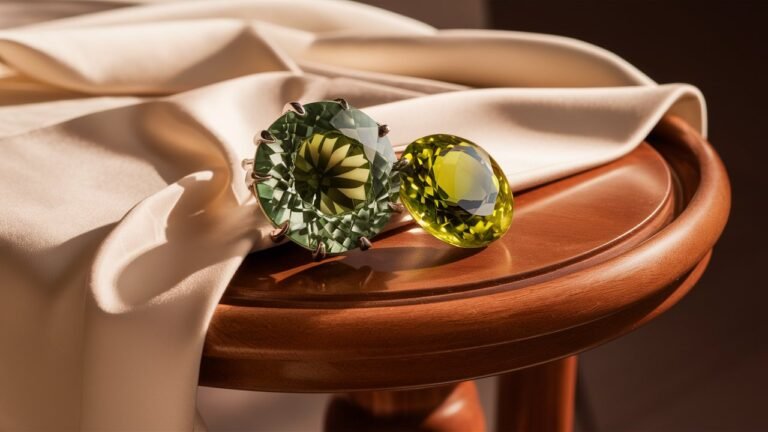Imagine walking through a jeweler’s workshop. The air is filled with the sound of machinery and the sparkle of precious stones. You see two types of gems: raw, uncut stones and polished ones. But what makes them different? Let’s explore the world of polished and cut gemstones.
Gemstones can be found in their natural state. They show a rugged beauty with unique patterns. These raw gems are like diamonds in the rough, ready to be transformed.
On the other hand, polished gemstones have been through a special process. This process, called lapidary, cuts, shapes, and polishes the stones. It makes them shine brighter and look more appealing.
The cutting and polishing process uses many techniques. These include sawing, grinding, sanding, and lapping. The goal is to bring out the gemstone’s best features. The final step gives the stone a mirror-like finish, making it sparkle even more.
Whether you like the charm of raw gemstones or the elegance of polished ones, it’s a personal choice. It depends on what you prefer, the look you want, and your budget. Knowing the difference between polished and cut gemstones can help you choose the perfect one for your jewelry or home decor.
Introduction to Gemstone Cutting and Polishing
Turning raw gemstones into shiny, polished gems is an art. This process, called lapidary, requires skill and patience. Gemstone cutters, or lapidaries, use special techniques to reveal each stone’s beauty.
The Art of Lapidary
Lapidary techniques include sawing, grinding, sanding, and lapping. Sawing uses a diamond-coated blade to cut the stone. Grinding and sanding shape and smooth the stone with finer abrasives. Lapping creates flat, shiny facets.
Gemstone Cutting Techniques
Gemstone cutters need to know a lot about minerals and light. This knowledge helps them choose the best way to cut and polish each gemstone. Most gemstones start as rough stones, needing expert care to shine.
Faceting adds cuts to gemstones to make them sparkle. Diamonds, for example, have many faceted cuts. The round brilliant cut is the most popular.
Polishing is the last step to make the gemstone shine. Cutters use diamond dust to polish the stone, making it bright and colorful.
Learning to cut gems takes years. Cutters must think about the stone’s shape, angles, and risk of damage. They aim to create a beautiful, sparkling gem.
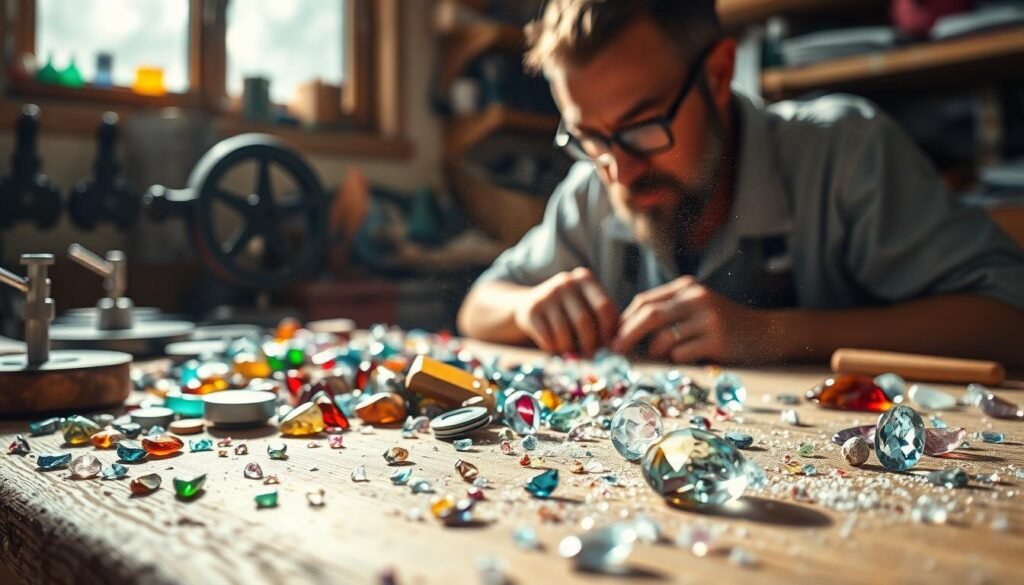
Polished vs Cut Gemstone: A Primer
When it comes to gemstones, polished and cut gems differ a lot. This difference affects their look, value, and appeal. Knowing this is key for anyone into jewelry, gemstone collecting, or just enjoying their beauty.
Raw, uncut gemstones show their natural, unpolished beauty. They have unique inclusions and patterns. These stones often have a rugged charm and are less expensive than polished ones.
Polished gemstones, however, have been cut and shaped to look better. This process removes flaws and makes the stone reflect light better. This makes polished gems more valuable than raw ones.
Choosing between raw and polished gems depends on your taste, the look you want, and your budget. Raw gemstones have a natural charm, while polished ones are more elegant. Either way, these gems are sure to amaze and inspire you.

The Process of Gemstone Cutting
Turning raw gemstones into beautiful, polished pieces is an art. The cutting process involves many important steps. These steps need skill, precision, and a lot of knowledge.
Sawing
The first step is sawing. Lapidaries use thin, diamond-coated blades to cut the stone. This helps them break the stone into parts that can be shaped and sized.
Grinding
After sawing, the stone is ground. Grinders use diamond or silicon carbide wheels to shape the stone. This step is key in making the stone look more refined.
Sanding
Then, sanding smooths out scratches from grinding. At this stage, finer abrasives are used. This allows for more control over the stone’s shape and finish.
Lapping
The last step is lapping. This uses a flat lap to create facets on the stone. Lapidaries use diamond-coated discs for a smooth finish. This step makes the gemstone shine brightly.
Each step in cutting gemstones requires special skills and patience. The craftsmen who do this work are true artists. They turn rough stones into stunning gems that amaze everyone.

Polishing Techniques for Gemstones
Unlocking the true brilliance and clarity of gemstones requires a meticulous polishing process. From diamonds to amethysts, the art of gemstone polishing transforms rough stones into dazzling works of art.
Let’s explore the various techniques used to enhance the visual appeal of these captivating natural wonders.
The Power of Abrasives
Polishing gemstones typically involves the use of fine-grained abrasives, such as diamond, aluminum oxide, cerium oxide, or chromium oxide. These abrasives are applied to a variety of surfaces, including tin, felt, leather, or wood, depending on the specific gemstone and the desired finish.
The polishing process gradually removes microscopic imperfections, revealing the stone’s innate gemstone brilliance and gemstone clarity.
Hand Polishing Techniques
- Start with coarse sandpaper grits (180, 400) to remove any significant imperfections.
- Gradually transition to finer grits (600, 1200) to achieve a smooth, mirror-like finish.
- Use a chopping board, tap water, and a tea towel to keep the gemstone and sandpaper lubricated during the polishing process.
Power Tool Polishing
For a more efficient polishing method, lapidaries often employ power tools, such as Dremels or hand drill tools. These tools allow for more precise control and a faster polishing process.
- Use a Dremel with a fine-tip marker to mark the cutting lines, then secure the gemstone in a vice or clamp.
- Apply a polishing compound to a clean cloth or polishing accessories, and gently buff the gemstone to a high-shine finish.
Regardless of the polishing technique, the ultimate goal is to enhance the natural beauty of the gemstone, maximizing its gemstone polishing and transforming it into a stunning work of art.
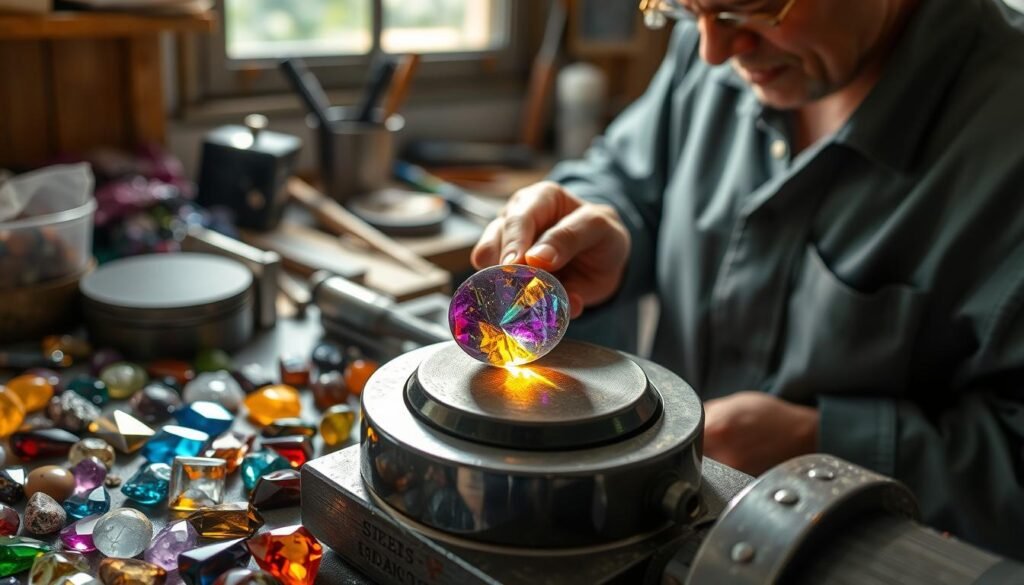
Faceting: The Art of Cutting Gemstones
Gemstone cutting and polishing are key to turning raw crystals into stunning gemstones. At the core of this process is faceting. It’s a technique that makes flat, symmetrical facets on a transparent gemstone’s surface.
Faceting Machines and Tools
Faceted stones are cut and polished with a faceting machine. This machine lets the cutter control the angle and position of each facet precisely. It has a rotating lap, a water supply for cooling, and an adjustable handpiece for the gemstone.
Faceters use tools like dop sticks, index gears, and protractors. These tools help ensure the gemstone’s symmetry and proportions are perfect.
New faceting techniques, like concave facets and grooves, have created unique gemstone cuts. The careful planning and execution are key to enhancing the gemstone’s optical performance and beauty.
| Faceting Technique | Description |
|---|---|
| Grinding | A technique used to remove excess material and shape the rough crystal. |
| Cabochon Cutting | Creates a smooth and domed shape on the top surface of the gemstone. |
| Faceting | Involves cutting and polishing precise flat surfaces, known as facets, onto the gemstone. |
| Preshaping | A foundational step that prepares the rough stone for the faceting process. |
| Polishing | The final step that adds a high luster and brilliance to the gemstone. |
Faceting is a complex art that needs a deep understanding of gemstones and cutting techniques. It requires specialized equipment and tools. By carefully setting the angles and positions of facets, faceters can bring out the gemstone’s full beauty.

Gemstone Shapes and Cuts
Gemstones can be cut into many shapes, from classic round brilliant to fancy shapes. Each shape has its own look, making it key when picking a gemstone for jewelry.
Round and Brilliant Cuts
The round brilliant cut is a top pick for diamond rings, especially in solitaire styles. It has 58 facets, designed to maximize sparkle since the 17th century. Marcel Tolkowsky refined it in 1919 to enhance its fire and shine.
Fancy Shapes: Oval, Marquise, and More
There are many “fancy” gemstone shapes, each with its own charm. The oval shape, often in rings, has 58 facets and can make fingers look longer. The marquise shape, though less common, is attractive and can have a French tip for more sparkle.
Other fancy shapes include the cushion, pear, heart, asscher, and radiant cuts. Each has its own faceting and look. These cuts mix flat and rounded surfaces for a striking appearance.
| Gemstone Cut | Facet Count | Key Features |
|---|---|---|
| Round Brilliant | 58 | Optimal fire and sparkle, classic choice for diamond rings |
| Oval | 58 | Visually elongates and slims fingers, often used in rings |
| Marquise | 57-58 | Elegant, attractive shape, can feature French tip |
| Cushion | Various | Square or rectangular shape with large facets, conceals imperfections |
| Pear (Teardrop) | Various | Feminine, elegant shape, may exhibit a bow tie effect |
Choosing a gemstone shape and cut is all about the look you want and the gemstone’s quality. Whether you love the classic round cut or fancy shapes, there’s a cut for everyone’s style.

Polished Vs Cut Gemstone
Gemstones can be polished or cut. Polished gems have been shaped to look better. They show off their color and clarity more. Unpolished gems, on the other hand, have a natural look.
Polishing makes gems more expensive but also more durable. It makes them better for jewelry. This process removes flaws and makes the gem shine more.
Gemstone Shapes and Cuts: Enhancing Appearance and Value
Gemstone cutters choose cuts based on the gem’s type and quality. The cut affects the gem’s value and how it looks. Here are some popular cuts:
- Round and Brilliant Cuts: These cuts are bright and lively, loved since the 17th century.
- Oval Cut: This shape makes the gem look bigger than it is, thanks to its design.
- Cushion Cut: It scatters light well, hiding flaws with its unique shape.
- Pear (Teardrop) Shape: This shape is seen as feminine, with different cuts available.
- Marquise Cut: Its long, pointed shape has lots of facets, making it sparkle.
- Princess Cut: A modern choice, it’s square and has lots of facets for brilliance.
- Heart Shape: Romantic and versatile, it has many facets to enhance its look.
Choosing between polished and uncut gems depends on what you like and need. It’s about finding the right balance between gemstone appearance and gemstone value.
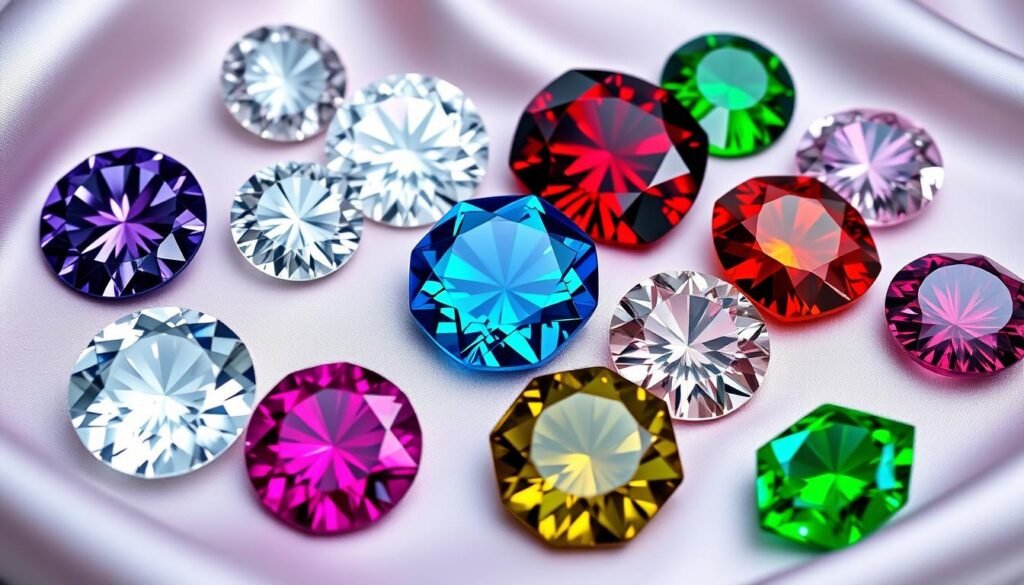
Raw Gemstones: The Natural Beauty
Raw, uncut gemstones bring a unique, earthy charm. They have inclusions and shapes that polished gems can’t match. Plus, they’re often cheaper, making them a great choice for those watching their budget.
Pros and Cons of Raw Gemstones
Raw gemstones have a natural beauty that’s hard to resist. Their rough surfaces add a special texture to jewelry. But, they might chip or break more easily than polished stones.
Their size and shape options are also limited. This can make them hard to use in some designs.
The feel of raw gemstones can be different too. They might be too rough for some, especially in rings or bracelets. If you prefer a smooth, shiny look, raw gemstones might not be for you.
| Pros of Raw Gemstones | Cons of Raw Gemstones |
|---|---|
|
|
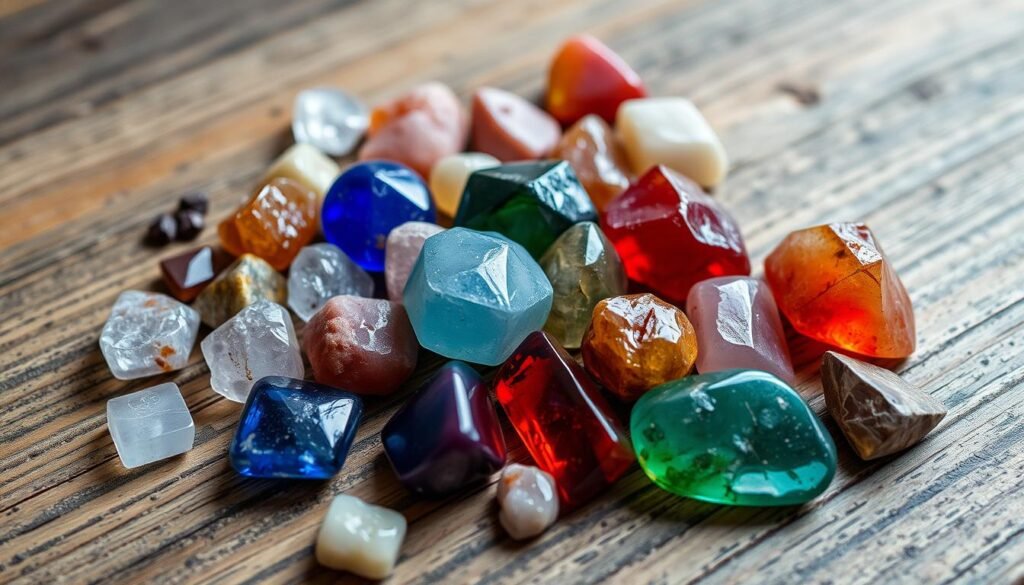
Choosing between raw and polished gemstones depends on what you like. Raw gemstones offer a natural, unique look. Polished stones provide a refined, elegant feel. Knowing the pros and cons helps you pick what fits your style and budget.
Polished Gemstones: Refined Elegance
Polishing gemstones brings out their refined elegance. This process cuts and shapes them to remove flaws. It makes them sparkle and shine, making polished gems very popular in jewelry.
Advantages of Polished Gemstones
Polished gemstones are more durable than raw ones. The cutting and polishing make them less likely to chip or break. They also come in many shapes and cuts, like round brilliant and emerald, which adds to their versatility in jewelry.
These stones show off their true beauty and clarity. The polishing process gets rid of imperfections, enhancing the gemstone brilliance. This makes them highly valued for their polished and sophisticated look.
Drawbacks of Polished Gemstones
There are downsides to polished gemstones too. They cost more because of the extra work and skill needed. Some people think they lose the natural charm of raw stones, seeing them as less authentic.
In the end, whether to choose polished vs raw gemstones depends on what you like. Both polished gems and raw stones have their appeal. There’s a gemstone for everyone, no matter your taste or budget.

Choosing Between Raw and Polished Gemstones
Choosing between raw and polished gemstones for your jewelry is a big decision. It depends on the look you want, the type of jewelry, and your budget.
Raw gemstones give a natural, organic look. Their rough surfaces and shapes add depth and character. But, they might not be as durable as polished gems.
Polished gemstones, however, offer a refined elegance. They are durable and can handle daily wear. The polishing process makes them shine brighter, enhancing their beauty.
Cost is another key factor. Polished gemstones are pricier because of the extra work. Raw gems are cheaper, making them a budget-friendly choice.
In the end, your preference and jewelry design needs decide. Think about your goals and choose wisely.
Gemstone Cutting: An Exact Craft with Tradition
Gemstone cutting is an ancient art that has evolved over centuries. It needs a deep knowledge of minerals and light. Skilled gemcutters carefully choose the best way to cut and polish each gemstone. This makes the gem shine brightly and look beautiful.
The process of cutting a gemstone involves many precise steps. These include sawing, grinding, sanding, and lapping. Each step is crucial in shaping and polishing the stone. Even small changes in cut and proportions can greatly affect how the gemstone looks.
Despite new technology, about 35% of gemcutters still use traditional methods. They keep alive the old techniques passed down through generations. This shows how important gemstone cutting tradition, lapidary expertise, and skilled gemstone cutting are in the field.
The global market for lapidary equipment is growing at about 5% each year. This is from 2021 to 2026. It shows the demand for high-quality, expertly-cut gemstones is steady. Now, 67% of gemcutters use advanced tools like diamond saws and lasers to improve their work.
Gemstone cutting is a precise science that needs a lot of attention to detail. It requires the skill of highly trained professionals. By understanding this process and the importance of tradition, you can see the true beauty and value of a well-cut gemstone.
Gemstone Shapes and Cuts in Jewelry
The shape and cut of a gemstone greatly affect a jewelry piece’s design and look. From the classic round brilliant cut to fancy shapes, choosing the right cut is key. It’s a crucial part of jewelry design.
The brilliant cut diamond is famous for its brilliance and fire. Introduced in 1919, it’s a standout. Oval cuts make fingers look longer, while cushion cuts scatter light and hide flaws. Marquise shapes add length and sparkle with a French tip.
Modern jewelry often features innovative cuts like the princess and Asscher. These cuts have 58 facets for extra sparkle. Shapes like triangles and kites add uniqueness, highlighting the gemstone’s beauty and quality.
| Gemstone Cut | Characteristics | Ideal Use |
|---|---|---|
| Round Brilliant | Optimal brilliance and fire, classic and timeless | Engagement and wedding rings |
| Oval | Visually elongates fingers, 58 facets for lustre | Everyday jewelry, cocktail rings |
| Cushion | Large facets to scatter light, conceal imperfections | Vintage-inspired jewelry, halo settings |
| Marquise | Elongated brilliant cut, enhanced lustre with French tip | Statement rings, necklaces |
| Princess | 58 facets for brilliance and fire, hides imperfections | Solitaire rings, studs, pendants |
Choosing gemstone shapes and cuts depends on the desired look and the jewelry piece. Consider the stone’s inclusions, color, and availability. This way, you can create unique and captivating jewelry that highlights the gemstones’ beauty.
Conclusion
Choosing between polished and raw stones for jewelry is a big decision. Both have their own special qualities. Polished gems shine with elegance, while raw stones have a natural charm.
The choice depends on what you like, the jewelry you’re making, and your budget. Knowing the differences in how they’re cut and polished helps you decide. This way, you can create stunning jewelry that meets your vision.
Quality gemstones, like those from Thai Gems, make your jewelry stand out. They focus on cutting and polishing to perfection. This ensures your polished vs cut gemstone choices are top-notch. By understanding gemstone selection, you can create jewelry design that wows your customers.



